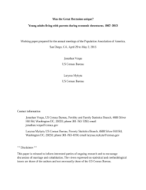
An official website of the United States government
Here’s how you know
Official websites use .gov
A .gov website belongs to an official government organization in the United States.
Secure .gov websites use HTTPS
A lock (
) or https:// means you’ve safely connected to the .gov website. Share sensitive information only on official, secure websites.
-
//
- Census.gov /
- Library /
- Census Working Papers /
- Was the Great Recession Unique?
Was the Great Recession unique? Young adults living with parents during economic downturns, 1967–2013
Was the Great Recession unique? Young adults living with parents during economic downturns, 1967–2013
Abstract
Using the Current Population Survey (1967–2013), we describe historical changes in the population of 25–34 year olds who lived in the parental home against the seven recessions the United States has experienced since 1967. In addition to individual characteristics, we explore the role of structural factors such as unemployment rates, housing costs and growth in the size of Boomer and Millennial cohorts, owing that economic conditions and population pressures may explain historical trends. To this end we use decomposition analysis to calculate period differences in living in the parental home that are attributable to changing economic effects and to changing population pressures. The odds of living in the parental home were no different during the Great Recession than periods of economic expansion. Over the last 45 years, the rise in living in the parental home has been largely attributable to population growth and delays in marriage, not the changing size or effect of unemployment rates or rental housing costs. Indeed, population growth accelerated the rising in living with parents during the 1980s (as many Baby Boomers came of age), and acted as a break during the 2000s. In recent years delays in marriage are greatly accelerating the proportion of young adults living with their parents.
Share
Some content on this site is available in several different electronic formats. Some of the files may require a plug-in or additional software to view.
 Yes
Yes
 No
NoComments or suggestions?


Top

